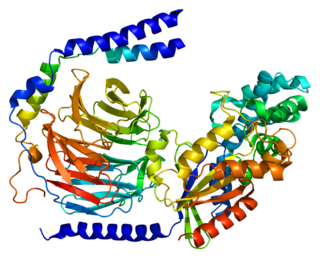
Calcium/calmodulin-dependent protein kinase type II subunit alpha (CAMKIIα), a.k.a.Ca2+/calmodulin-dependent protein kinase II alpha, is one subunit of CamKII, a protein kinase (i.e., an enzyme which phosphorylates proteins) that in humans is encoded by the CAMK2A gene.

Calcium/calmodulin-dependent protein kinase type II beta chain is an enzyme that in humans is encoded by the CAMK2B gene.

Cyclic AMP-dependent transcription factor ATF-1 is a protein that in humans is encoded by the ATF1 gene.

Peripheral plasma membrane protein CASK is a protein that in humans is encoded by the CASK gene. This gene is also known by several other names: CMG 2, calcium/calmodulin-dependent serine protein kinase 3 and membrane-associated guanylate kinase 2. CASK gene mutations are the cause of XL-ID with or without nystagmus and MICPCH, an X-linked neurological disorder.

Calcium/calmodulin-dependent protein kinase type IV is an enzyme that in humans is encoded by the CAMK4 gene.

Calcium/calmodulin-dependent protein kinase type II gamma chain is an enzyme that in humans is encoded by the CAMK2G gene.

Calpain-1 catalytic subunit(CANP 1) is a protein that in humans is encoded by the CAPN1 gene.

Calcium/calmodulin-dependent protein kinase type 1 is an enzyme that in humans is encoded by the CAMK1 gene.

1-Phosphatidylinositol-4,5-bisphosphate phosphodiesterase beta-3 is an enzyme that in humans is encoded by the PLCB3 gene.

Guanine nucleotide-binding protein G(I)/G(S)/G(O) subunit gamma-2 is a protein that in humans is encoded by the GNG2 gene.

Calcium/calmodulin-dependent protein kinase type II delta chain is an enzyme that in humans is encoded by the CAMK2D gene.

Protein tyrosine phosphatase non-receptor type 7 is an enzyme that in humans is encoded by the PTPN7 gene.

Eukaryotic elongation factor-2 kinase, also known as calmodulin-dependent protein kinase III (CAMKIII) and calcium/calmodulin-dependent eukaryotic elongation factor 2 kinase, is an enzyme that in humans is encoded by the EEF2K gene.

Integrin beta-1-binding protein 1 is a protein that in humans is encoded by the ITGB1BP1 gene.

Protein BEX3 is a protein that in humans is encoded by the NGFRAP1 gene.

Calcium/calmodulin-dependent protein kinase kinase 1 is an enzyme that in humans is encoded by the CAMKK1 gene.

Calcium/calmodulin-dependent protein kinase kinase 2 is an enzyme that in humans is encoded by the CAMKK2 gene.

Calcium channel, voltage-dependent, T type, alpha 1H subunit, also known as CACNA1H, is a protein which in humans is encoded by the CACNA1H gene.

Calcium/calmodulin dependent protein kinase II inhibitor 1 is a protein that in humans is encoded by the CAMK2N1 gene.

Sushi domain containing 2 is a protein that in humans is encoded by the SUSD2 gene.






















